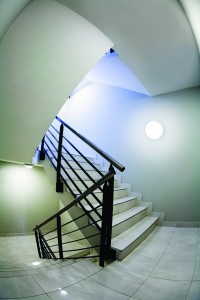Recently added item(s)
You have no items in your basket.

Many building owners see emergency lighting as a ‘fit and forget’ system a survey has found, with almost 75 per cent considering the maintenance of such lighting as being simply a ‘tick box’ exercise.
However, according to The Industry Committee for Emergency Lighting (ICEL), the legal requirement is that non-domestic buildings must be safe at all times, even if mains power failure occurs. Therefore, nearly all such buildings must have emergency lighting fitted and maintained and this is the legal responsibility of the person in charge of the building.
The survey, commissioned by fire detection manufacturer Hochiki Europe, also reveals that 56 per cent of European businesses are failing to keep their fire safety systems up to date following internal fit-outs and refurbishments; for example, when walls are put up or doors moved to suit new requirements but the emergency lighting isn’t altered to suit the resulting changes to designated escape routes.
Fire safety regulations require a building owner to undertake a new fire risk assessment when a room or building has had a change of use but many simply do not realise that this is their legal responsibility. This includes making sure that fire-fighting equipment locations are properly illuminated and that there is sufficient signage to ensure that people know which routes to take to leave the building. If this equipment is shifted from one place to another, then dedicated lighting must also be moved at the same time.
Emergency Lighting falls into two primary categories. 'Standby Lighting' and 'Escape Lighting’. Standby Lighting allows companies to continue to occupy a building safely during a power outage with up to 3 hours of 'Standby Power' and has nothing to do with evacuation. 'Escape Lighting' on the other hand, illuminates the escape routes when there is a need to evacuate the building.
However, building owners and managers should be aware that they must recharge the batteries of the emergency lighting on the premises following use or routine testing otherwise they will be breaking the law if the emergency lighting is not functional again before reoccupation.
The survey also highlighted that the emergency lighting installations in half of our public buildings no longer meets the required lighting standards. The top five failings reported were:
Inadequate emergency lighting signage
Inadequate illuminance levels
Blocked emergency exits
Batteries not charged or not working
Inadequate logbook records being kept
Life is precious and property and assets matter, so if you need advice or guidance about any fire safety product - including emergency lighting, the Fire Depot team of technical experts is available to provide help and advice. Call us today on 0330 999 2233